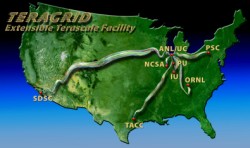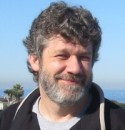

|
|
| April 2006 | |
| Harnessing Supercomputers to Model Life |
|
||
For the first time, researchers have visualized the changing atomic structure of a virus by using powerful computers to calculate how each of the virus' one million atoms interacts every femtosecond, or one-millionth-of-a-billionth of a second. The NSF-funded simulation revealed key physical properties of satellite tobacco mosaic virus, a simple, plant-infecting virus. A better understanding of viral mechanisms helps researchers design improved strategies to combat viral infections in plants, people and other animals. Led by Klaus Schulten of the University of Illinois at Urbana-Champaign, the research team tapped high-performance computing power at the National Center for Supercomputing Applications to run the simulation. Still, it took about 100 days to generate just 50 nanoseconds of virus activity. Ultimately, scientists will generate longer simulations from bigger biological entities; but to do so, they need the next generation of supercomputers. NSF is currently devising a national strategy to give scientists and engineers the resources needed to tackle their most computationally intensive research problems. |
|||
| For more on the first virus simulation, see "Supercomputer Maps One Million Atoms of a Complete Virus in First Simulation of a Life Form." | |||
| New "Voice over Internet Protocol" Test Bed Will Improve Security | |||
|
NSF has issued four awards totaling $600,000 to a University of North Texas-led, multi-university collaboration to develop a geographically distributed, secure test bed to analyze vulnerabilities in Voice over Internet Protocol (VoIP) -- an increasingly popular technology that turns audio signals into digital data that can be transmitted over the Internet. The three-year project will investigate voice spam prevention (VoIP systems can be spammed like email), attacks on networks and Internet resources that render them unavailable (denial of service), quality of service, and 911-service dependability. The test bed will also be used to discern security holes arising from VoIP interacting with conventional phone networks. VoIP allows users with a computer and a standard Internet connection to make toll-free calls anywhere in the world. Companies such as Vonage and AT&T are aggressively deploying the technology, and one study predicts some 24 million U.S. households will be using VoIP by 2008. |
||
The project also includes researchers and resources at Columbia University, Purdue University and the University of California-Davis. The team is committed to disseminating its findings throughout academia, industry and government, giving all technology developers guidelines for preventing security breaches. See "Collaboration Will Investigate Vulnerabilities of Rapidly Growing Internet Phone and Multimedia Systems" for more details. |
|||
| Sticky Bacterium Produces Natural Superglue |
|
||
The glue that one species of water-loving bacterium uses to grip its surroundings may be the strongest known natural adhesive. If the material proves easy to mass produce, it could have applications in medicine, marine technology and other areas. Researchers at Indiana University and Brown University studied how much force they needed to tug the tiny, stalked Caulobacter crescentus off a glass plate. The bacteria grip with a force of five tons per square inch -- equivalent to the downward force exerted by three cars balancing on a spot the size of a quarter. While the researchers do not yet know if the substance is the strongest glue on Earth, it is stronger than cyanoacrylate superglues found on store shelves and may be rivaled by only a few synthetics. Funding for this study came from the Division of Materials Research in the Mathematics and Physical Sciences Directorate. For more information, see "Waterproof Superglue May Be Strongest in Nature." |
|||
| Microcapsule Offers Potential Drug Delivery Technology | |||
(back to top) |
A tiny, temperature-sensitive capsule could prove to be a major breakthrough for both medicine and cosmetics. Sahraoui Chaieb -- a physicist and NSF CAREER awardee -- together with his colleagues at the University of Illinois at Urbana-Champaign crafted tiny, hollow capsules from lipids that wrinkle and collapse when cooled below body temperature. The collapsed capsules, ranging in size from 10 to 100 micrometers across, squeeze out chemicals in a controlled manner. The capsules are in the earliest stages of development and not yet ready for medical use, but the researchers are discussing potential applications of the technology with a cosmetics company. Before the capsules can deliver medicine, the researchers say they must develop a mechanism to cool the tiny pills without endangering surrounding body tissues. For more information, see "Micro Pills Could Deliver Drugs on Demand." |
||
|
|||
| NSF Nurtures Small Companies with Big Ideas | |||
NSF piloted the Small Business Innovation Research (SBIR) and Small Business Technology Transfer (STTR) Programs over 20 years ago. Since then, the programs have spread to 10 federal agencies. Coordinated by the Small Business Administration, these agencies collectively support over $2 billion in innovation research each year. Such programs have nurtured small companies into major market leaders, such as Symantec, Qualcomm, Sensant (now part of Siemens), Vivisimo, Displaytech and Aurora Flight Sciences. NSF awarded more than 300 SBIR/STTR grants in FY 2005, for a total investment of $100 million. The success of the SBIR/STTR programs has led to their replication around the world as nations strive to find new ways to compete in the global, technology-enabled, innovation economy. See the NSF Fact Sheet for more SBIR/STTR breakthroughs. |
| (back to top) | |
|
| Catlett Touts TeraGrid for all of Science and Engineering | ||
 |
The NSF-supported TeraGrid was fully deployed in Sept. 2004 as a national computing and data storage network that combines resources from eight partner sites. By accessing the TeraGrid, researchers from all fields of science and engineering are applying high-performance computing power to their studies. Recently, we had a little data exchange of our own with TeraGrid Director Charlie Catlett (pictured at right). |
 |
NSF: Why is it called the "TeraGrid?" Catlett: "Tera" is a prefix meaning "trillion." By connecting some of our nation's most powerful computing resources, we created a system that can perform 100 trillion floating point operations per second -- or 100 teraflops. In comparison, a high-end desktop computer today performs in the range of a few billion flops. So, the TeraGrid is in some sense like 50,000 desktop computers working together. NSF: Is the TeraGrid a unique resource? Catlett: The TeraGrid is the most powerful open computational facility in the world. While there are similar "grid" projects, TeraGrid offers the unique advantage of tightly coupled, distributed computing resources for scientific discovery that would not be possible within a single computer center. Another unique aspect of TeraGrid is the Science Gateways Initiative. Rather than assuming that scientists will adapt their work to fit our systems, the TeraGrid accommodates pre-existing tools, databases and collaborative sites that scientists in their respective fields have already built. Science Gateways are plugged directly into the TeraGrid, making TeraGrid much more inviting and productive for researchers. Users can access TeraGrid through systems to which they are already accustomed while the computing infrastructure functions transparently in the background. NSF: How many researchers are using the TeraGrid? Catlett: As of early this month, we provided computational support for well over 3,500 researchers working on more than 1,000 scientific projects. NSF: What's next for TeraGrid? Catlett: We have several challenges ahead of us. The first is to really make these new "grid" computing tools and services easier to use so that researchers can focus on science rather than computers. We are also concentrating on making sure that our information management, analysis, and data movement infrastructure can continue to support a new generation of data-centric science as the volume of data grows by an order of magnitude. Lastly, we are carefully considering the future workforce. Today's students can now engage in scientific discovery using TeraGrid computing resources. When they enter the workforce, we want them familiar with authentic science -- including advanced computing tools. NSF: Do you consider yourself a computer geek? Catlett: I'm such a computer geek that I used a GPS to track our location on a cruise during spring break. I've already "mashed" the track with pictures on a Google map. It's not technology that I'm a geek about -- it's what you can do with it. I've worked in supercomputing for 23 years now. And though I enjoy the technology, the real lessons I've retained have to do with under-standing how scientists, educators and students do their work with these tools, and what makes things easier for them to stay productive. |
||
|
||
|
||||||
Climate-Monitoring Satellites Successfully Launched Into Orbit -- Associated Press (04/16/06) -- Six weather satellites successfully reached orbit Saturday, launching their five-year mission to monitor hurricanes, climate change, and space weather. The $100 million effort is jointly funded by Taiwan and several federal agencies in the United States, including the National Science Foundation. Chimps Could Hold HIV Key -- Rocky Mountain News (04/10/06) -- Aurora, Colo.-based Evolutionary Genomics earlier this year received its second $500,000 National Science Foundation grant to study the differences between chimpanzee and human DNA that make the former resistant to AIDS and the latter receptive to it. It is believed that chimps were carriers of HIV for at least a million years before it passed to humans. |
||||||
|
||||||
|
||||||
|
||||||
|
||||||
|
The National Science Foundation (NSF) is an independent federal agency that supports fundamental research and education across all fields of science with an annual budget of nearly $5.58 billion. NSF funding reaches all 50 states through grants to roughly 1,700 universities and institutions. Each year, NSF receives about 40,000 competitive requests for funding and makes about 10,000 new funding awards. The NSF also awards over $400 million in professional and service contracts yearly. Contact NSF's Office of Legislative and Public Affairs for more information, to unsubscribe, or for permission to reuse newsletter images. |